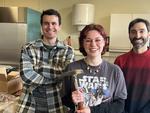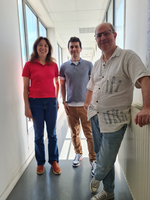James A. Behan
Chargé de Recherche/Assistant Professor CNRS
Institut des Sciences Chimiques de Rennes
Welcome to the homepage for the lab of Dr James A. Behan, Chargé de Recherche CNRS.
I am a researcher working at the interface of electrochemistry, nanomaterials and microbiology for applications in catalysis, green synthesis of novel materials and advancing our understanding of bio-nano interactions.
Download my Curriculum Vitae.
Contact me at james.behan@univ-rennes.fr for questions. I am always looking for new collaborations!
Check out the most recent news from the team.
See all of our publications.
Recent Publications
News
Recent and Upcoming Talks
Experience
Responsibilities include:
- Investigation of capacity of bacterial biofilms to synthesise novel electrocatalysts
- Writing and publishing original research
- Advising and supervising PhD candidates and other junior students
Responsibilities included:
- My project NANO-INT focused on the investigation of nanomaterial - biological system interactions
- This involved a combination of nanoparticle synthesis and surface modification
- Supervision of numerous PhD, Masters and Project Students
- Co-coordinator Bio-Nano Master’s module with Prof. Kenneth Dawson (2019-2020)
Responsibilities included:
- Designed and produced lecture series in thermodynamics aimed at applications in pharmacy
- ca. 100 students in 1st and 2nd year pharmacy
- 20 lecture contact hours in addition to tutorials, pre-exam sessions
- Prepared and set final exam questions and marking scheme
Description of work:
- Prepared and delivered lecture and tutorial series aimed at students new to the field
- Part time position held concomitantly with PhD and Physical Chemistry lecturing duties
- Multiple 1-2 H sessions/week with a dozen students per session
- Prepared multiple self-test and exam preparatory sessions, supplementary notes and worked problem examples
Description of work:
- Synthesis and investigation of carbon nanomaterials for electrocatalytic and electroanalytic applications
- Heteroatom doped nanocarbons for oxygen reduction
- Modifying carbon electrode interfaces for favourable bio-nano interactions
- Proficiency in variety of electrochemical, spectroscopic and optoelectronic characterisation techniques
Committed to Open Access Publishing
Trained in statistical analysis
Projects
“BauxCLEAN” - CNRS 80Prime Interdisciplinary Project on the Clean Extraction of Iron from Bauxites Using Electroactive Bacteria
Following on from the MicroBaux project, we were privileged to obtain financing for a 3-year doctoral fellowship to continue this exciting research! This project, entitled BauxCLEAN, will expand the preliminary studies of MicroBAUX.
“MicroBaux” - CNRS Interdisciplinary Project on the Clean Extraction of Iron from Bauxites Using Electroactive Bacteria
The extraction of aluminium from Bauxite requires a separation from other undesirable components such as iron by acid leaching and high temperature annealing, which leaves a non-exploited ‘red mud’ with both economic and environmental implications.





